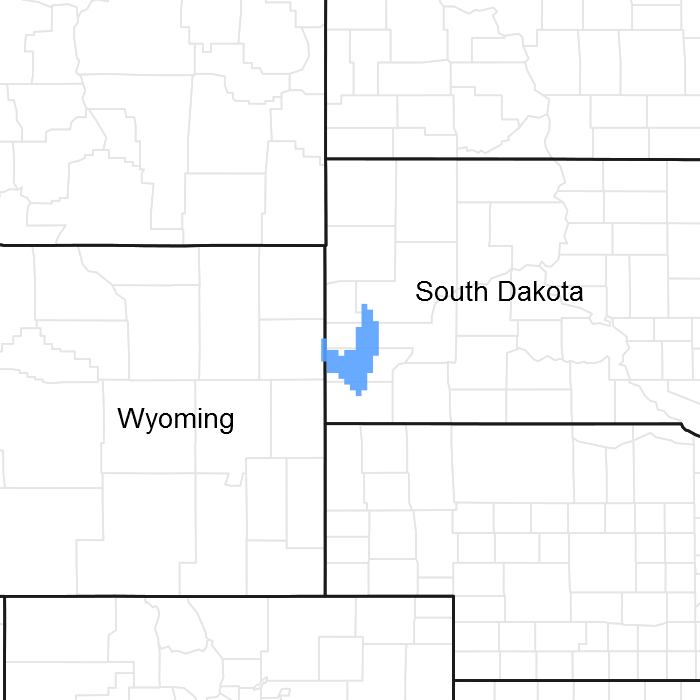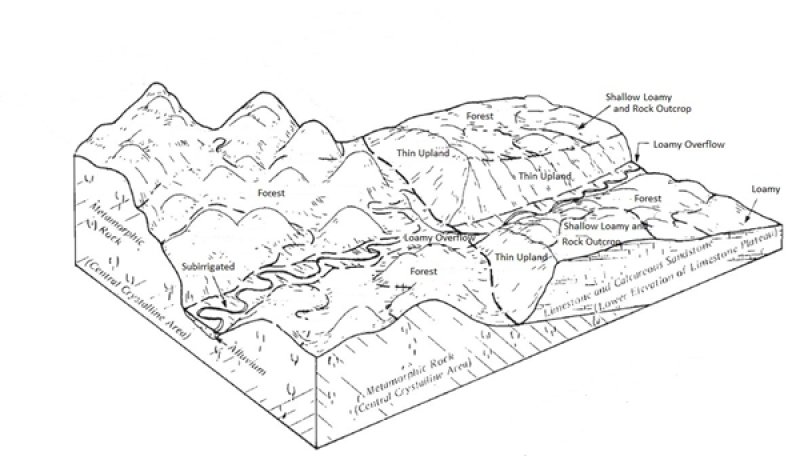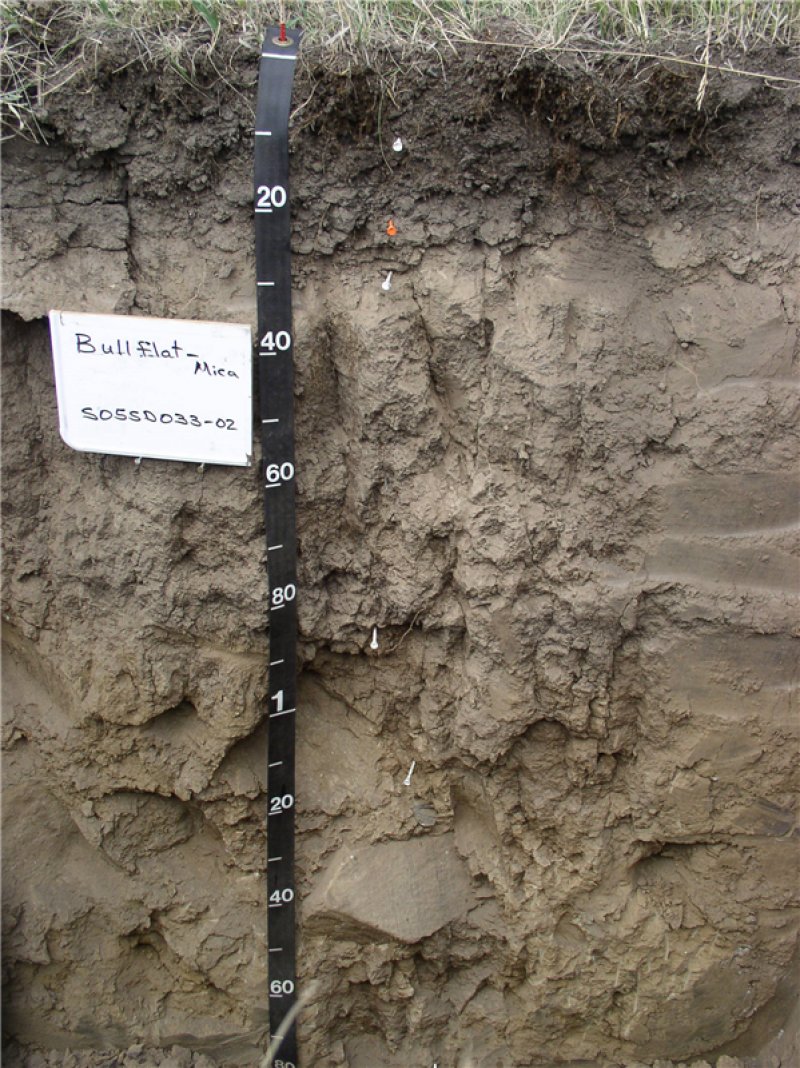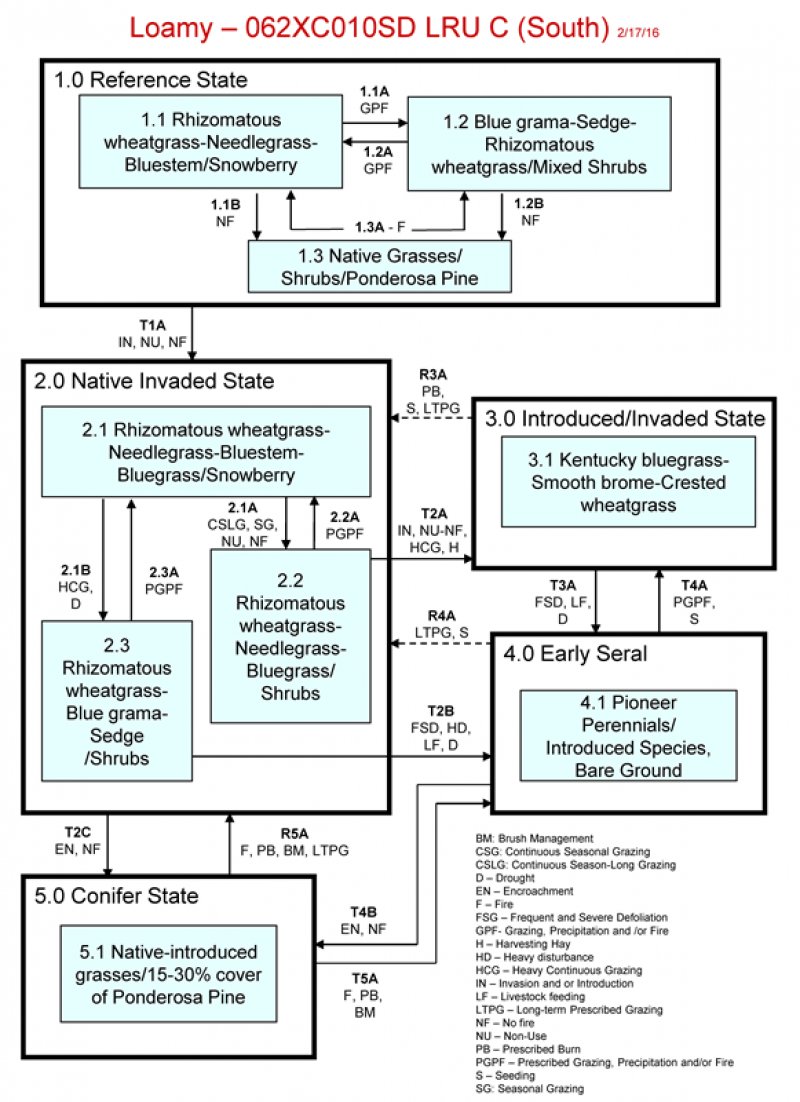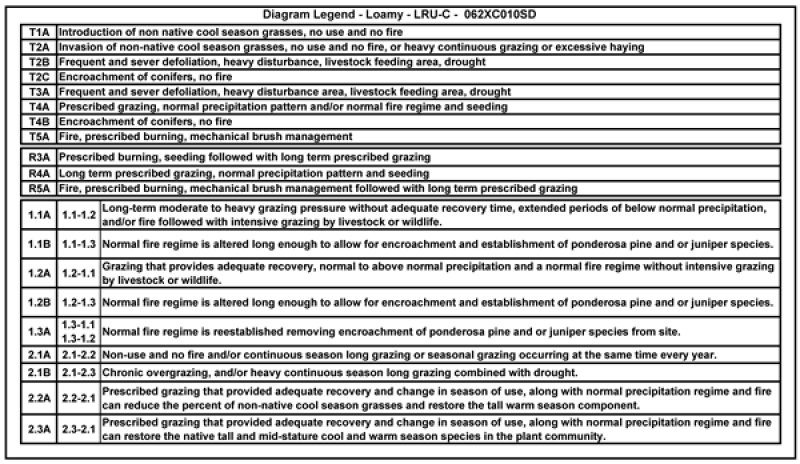Ecological dynamics
Black Hills vegetation types consist of a mixture of forest and grasslands resulting from the varied topography, geology, soils, climate and natural disturbances. Frequent fires, periodic drought, and episodic mountain pine beetle infestations all contribute to the maintenance of large open grasslands scattered throughout the Black Hills. Ponderosa pine is the dominant tree species in the Black Hills. It is a fire adapted species that coexists with frequent, low-intensity fires that consume small seedlings, prune lower branches from larger trees, and reduce fuel loads on the forest floor.
This site developed under Black Hills climatic conditions with short-term weather variations, light to severe grazing by bison, elk, insects and small mammals, sporadic natural or man-caused wildfire (often of light intensities), and other biotic and abiotic factors that typically influence soil/site development. The natural fire regime maintained this site as a grassland and the plant communities were free of non-native cool season grasses.
Fire, or the lack of fire, is one of the major drivers, along with grazing, and introduced non-native cool season grasses that shape this site as well as adjacent ecological sites. Between 1388 and 1900, fire intervals in the Black Hills ranged from 16 to 20 years (Brown, 1996). In the absence of fire, encroachment of ponderosa pine is likely to occur on this site. The Loamy ecological site is not as susceptible to encroachment as the Shallow Loamy site but because they typically adjoin, encroachment occurs and untreated, pine will become established. Competition with the dominant cool season grasses on the Loamy site hinder establishment of pine seedlings, whereas the gravelly and stony soils on the Shallow Loamy site typically dominated by warm season grasses do not provide that direct competition early in the growing season.
Kentucky bluegrass and to a lesser degree smooth brome are common cool season grass species throughout MLRA 62. Because the Black Hills have higher precipitation amounts and cooler spring and fall periods than the surrounding MLRA 61, these non-native cool season grasses can easily become the dominant species on this site. Improper grazing management, and non-use and/or no fire can also cause these species to increase and become the dominant species in plant communities.
Changes will occur in the plant communities due to short-term weather variations, impacts of native and/or exotic plant and animal species, and management actions, severe disturbances, such as periods of well-below average precipitation, severe defoliation, excessive haying or no fire and no use can cause significant shifts in plant communities and/or species composition.
The Reference State is difficult to locate in this LRU with the introduction of non-native cool season grasses. Plant community phase 2.1 is most similar to the Reference State but because of the persistence of non-native cools season grasses a restoration pathway to the Reference State is not believed to be achievable.
Interpretations are primarily based on the Rhizomatous Wheatgrass-Needlegrass-Big Bluestem/Snowberry Plant Community Phase. It has been determined by observing rangeland relic areas, areas protected from excessive disturbance, and areas under long-term rotational grazing regimes. Trends in plant community dynamics ranging from heavily grazed to lightly grazed areas, seasonal use pastures, and historical accounts also have been used. Plant community phases, states, transitional pathways, and thresholds have been determined through similar observations and experience.
The following diagram illustrates the common plant community phases that can occur on the site and the transition pathways between communities. These are the most common plant community phases based on current knowledge and experience, and changes will be made as more data is collected. Narratives following the diagram contain more detail pertaining to the ecological processes.
State 1
Reference
This state represents the natural range of variability that dominated the dynamics in this ecological site prior to European settlement. The Reference State does exist currently but with the introduction and spread of non-native cools season grasses it can be difficult to locate in this LRU.
This site was dominated by cool and warm season grasses. In pre-European times the primary disturbances included fire, insects and grazing by large ungulates and small mammals. Favorable growing conditions occurred during the spring, and warm months of June and July. Routine and/or occasional fires, reduced tree cover and contributed to the ecological processes that maintained the reference plant community.
Community 1.1
Rhizomatous Wheatgrass-Needlegrass-Bluestem/Snowberry
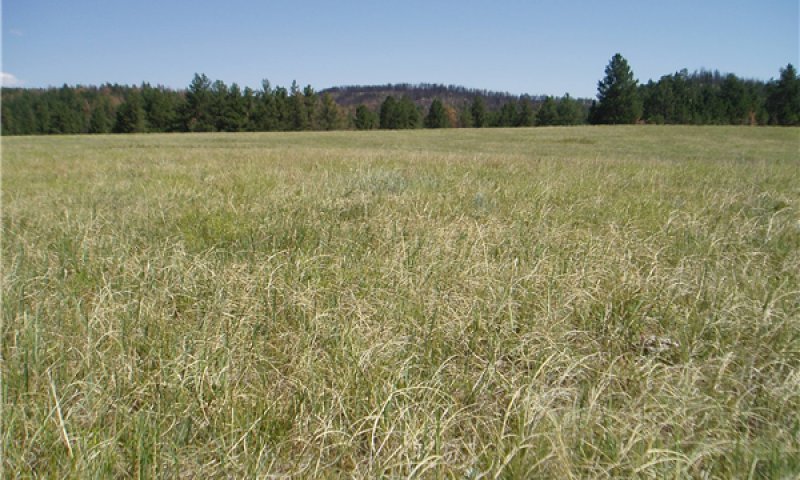
Figure 12. CPC: Rhizomatous wheatgrass-Needlegrass-Bluestem/S
Interpretations are based primarily on the Rhizomatous wheatgrass-Needlegrass-Bluestem/Snowberry plant community phase. This is also considered to be the reference or historic plant community. The potential vegetation is about 75 percent grass and grass-like plants, 15 percent forbs, 5 percent shrubs and 0 to 2 percent trees. Total annual production for a normal growing year is approximately 2,800 lbs./ac. The community is dominated by cool-season grasses and tall and mid-height warm season grasses. The dominant cool season grasses include western and bearded wheatgrass, green needlegrass, needleandthread and porcupine grass. Dominant warm season grasses are big bluestem, little bluestem, and sideoats grama. Other grasses include prairie dropseed, tall dropseed, blue grama, slender wheatgrass, plains muhly, and threadleaf sedge. The dominant shrub is western snowberry. This plant community was productive and resilient to disturbances such as drought and fire. It was a sustainable plant community in regards to soil/site stability, watershed function, and biological integrity.
Table 5. Annual production by plant type
| Plant type |
Low
(lb/acre) |
Representative value
(lb/acre) |
High
(lb/acre) |
| Grass/Grasslike |
1830 |
2282 |
2690 |
| Shrub/Vine |
135 |
280 |
450 |
| Forb |
135 |
210 |
300 |
| Tree |
0 |
28 |
60 |
| Total |
2100 |
2800 |
3500 |
| Jan |
Feb |
Mar |
Apr |
May |
Jun |
Jul |
Aug |
Sep |
Oct |
Nov |
Dec |
| J |
F |
M |
A |
M |
J |
J |
A |
S |
O |
N |
D |
Community 1.2
Blue grama-Sedge-Rhizomatous wheatgrass/Mixed Shrub
This plant community phase is a result of continuous season-long grazing or chronic overgrazing of livestock and/or wildlife and/or extended periods of below normal precipitation. The potential vegetation is about 65 percent grasses or grass-like plants, 15 percent forbs, and 20 percent shrubs. The community is dominated by warm season shortgrass species, with cool-season grasses being subdominant. Dominant grasses and grass-like species include blue grama, threadleaf sedge, western wheatgrass, and needleandthread. Other grass species include sideoats grama, bearded wheatgrass, plains muhly and three awn. Forbs commonly include cudweed sagewort, goldenrod, hairy golden aster, scurfpea, white prairie aster, and western ragweed. Shrubs have increase in percent composition. They include: western snowberry, fringed sagewort, rose, and green sagewort.
This plant community is resilient and well adapted to the Black Hills climatic conditions. The diversity in plant species allows for high drought tolerance. This is a sustainable plant community in regards to site/soil stability, watershed function, and biologic integrity. However, because blue grama and sedge have increased, runoff and infiltration will begin to be negatively affected.
Community 1.3
Native Grasses/Shrubs/Ponderosa Pine
This plant community phase is the result of no fire or when the normal fire interval has been extend allowing for conifers to encroach onto the site and become established. The herbaceous plant community can resemble the transition between PCP 1.1 and 1.2. Conifers are not the dominant species in this plant community phase (5-15% cover) and most trees will be removed once the natural fire regime is reestablished. This plant community is resilient and well adapted to the Black Hills climatic conditions. The diversity in plant species allows for high drought tolerance. This is a sustainable plant community in regards to site/soil stability, watershed function, and biologic integrity.
Pathway 1.1A
Community 1.1 to 1.2
Long-term moderate to heavy grazing pressure without adequate recovery time, extended periods of below normal precipitation, and/or fire followed with intensive grazing by livestock or wildlife can move this PCP 1.1 to PCP 1.2.
Pathway 1.1B
Community 1.1 to 1.3
The normal fire regime is altered long enough to allow for encroachment and establishment of ponderosa pine and or juniper species onto PCP 1.3.
Pathway 1.2A
Community 1.2 to 1.1
Grazing that provides adequate recovery, normal to above normal precipitation and a normal fire regime without intensive grazing by livestock or wildlife can move PCP 1.2 back to PCP 1.1.
Pathway 1.2B
Community 1.2 to 1.3
The normal fire regime is altered long enough to allow for encroachment and establishment of ponderosa pine and or juniper species onto PCP 1.3.
Pathway 1.3A
Community 1.3 to 1.1
The normal fire regime is reestablished. Pine and or juniper species are removed from PCP.
State 2
Native Invaded
This state represents what is most typically found on this site. The natural range of variability is influences by the presence of non-native cool season grasses, especially Kentucky bluegrass and smooth brome that can dominate the dynamics of this ecological site. Proper grazing management and periodic burning will maintain the productivity of this state. Heavy grazing without adequate recovery, extended periods of drought or non-use and no fire can put this state at risk of crossing a threshold.
Community 2.1
Rhizomatous wheatgrass-Needlegrass-Bluestem-Bluegrass/Snowberry
This plant community phase closely resembles the PCP 1.1 however non-native cool season grasses have invaded the site and under the current Black Hills climatic conditions will persist in the plant community. The potential vegetation is about 75 percent grass and grass-like plants, 15 percent forbs, 5 percent shrubs and 0 to 2 percent trees. Total annual production for a normal growing year is approximately 2,300 lbs./ac. The community is dominated by cool-season grasses and tall and mid-height warm season grasses. The dominant cool season grasses include western and bearded wheatgrass, needleandthread and porcupine grass. Kentucky bluegrass or other non-native cool season grasses can make up 2 to 5 percent of the plant community. Dominant warm season grasses are big bluestem, little bluestem, and sideoats grama. Other grasses include prairie dropseed, tall dropseed, blue grama, slender wheatgrass, plains muhly, and threadleaf sedge. The dominant shrub is western snowberry. This plant community is productive and resilient to disturbances such as drought and fire. It was a sustainable plant community in regards to soil/site stability, watershed function, and biological integrity. Management strategies must include techniques that will not cause Kentucky bluegrass and other non-native cool season grasses to increase significantly or this is at risk of transition to the Introduced/Invaded State.
Community 2.2
Rhizomatous wheatgrass-Needlegrass-Bluegrass/Shrub
This plant community evolved under continuous season-long grazing, seasonal grazing with no change in season of use or no use and no fire. This plant community phase is made up of approximately 85 percent grass and grass-like plants, 10 percent forbs, 5 percent shrubs and 0 to 2 percent trees. The community is dominated by cool-season grasses, with much of the warm season grass component being replaced by Kentucky bluegrass and other non-native cool season grasses. The dominant cool season grasses include western and bearded wheatgrass, needleandthread and porcupine grass. Kentucky bluegrass or other non-native cool season grasses can make up 5 to 20 percent of the plant community.
Community 2.3
Rhizomatous wheatgrass-Blue grama-Sedge/Shrubs
This plant community develops under heavy continuous grazing or from over utilization during extended drought periods. The potential plant community is made up of approximately 75 percent grasses and grass-like species, 15 percent forbs, and 10 percent shrubs. Dominant grasses include western wheatgrass, blue grama, and threadleaf sedge. Annual brome (cheatgrass and/or field brome) may also invade and become significant. Subdominant grasses include needleandthread, green needlegrass, hairy grama, sideoats grama, and Kentucky bluegrass. Forbs commonly found in this plant community include cudweed sagewort, goldenrod, scurfpea, and western ragweed.
Pathway 2.1A
Community 2.1 to 2.2
Non-use and no fire and/or continuous season long grazing or seasonal grazing occurring at the same time every year can move PCP 2.1 to PCP 2.2.
Pathway 2.1B
Community 2.1 to 2.3
Chronic overgrazing, and/or heavy continuous season long grazing combined with prolonged periods of below normal precipitation can move PCP 2.1 to PCP 2.3.
Pathway 2.2A
Community 2.2 to 2.1
Prescribed grazing that provided adequate recovery and change in season of use, along with normal precipitation regime and fire may reduce the percent of non-native cool season grasses in PCP 2.2 and restore the tall warm season component typical of PCP 2.1.
Pathway 2.3A
Community 2.3 to 2.1
Prescribed grazing that provided adequate recovery and change in season of use, along with normal precipitation regime and fire can restore the native tall and mid-stature cool and warm season species in the plant community typical of PCP 2.1.
State 3
Introduced/Invaded
This state typically occurs as a result of the site becoming dominated by non-native cool season grasses, primarily Kentucky bluegrass and/or smooth brome. This can be due to non-use and no fire which creates a large amount of litter, making the site unsuited for native species. Heavy continuous grazing and or mechanical harvesting can also create this state by over utilization of the native grass species, giving a competitive advantage to the non-native species which are adapted to heavy utilization and are grazing resistant.
Preliminary studies indicate that when Kentucky bluegrass exceeds 30 percent of the plant community and native grasses represent less than 40 percent of the plant community composition, a threshold has been crossed to an Introduced/Invaded State (3.0). Plant communities dominated by Kentucky bluegrass have significantly less cover and diversity of native grasses and forb species. (Toledo, D. et al., 2014).
Community 3.1
Kentucky bluegrass-Smooth brome-Crested Wheatgrass
This plant community is dominated by Kentucky bluegrass and/or other non-native cool season grasses (> 30 percent of PC). This plant community evolved under no use and no fire or with heavy continuous season-long grazing, or seasonal grazing with no change in season of use.
This plant community is made up of approximately 90 percent grasses and grass-like species, 5 percent forbs, and 5 percent shrubs. Dominant grasses include Kentucky bluegrass, smooth brome, and possibly crested wheatgrass. Western wheatgrass and some needlegrass may still be found in the plant community. Forbs commonly found in this plant community include cudweed sagewort, goldenrod, scurfpea, and western ragweed.
State 4
Early Seral
This state is the result of very heavy, concentrated disturbance such as cropping, concentrated rodent activity, or concentrated livestock areas. This State can develop as a result of invasion by highly competitive weed species such as Canada thistle, hound’s tongue, leafy spurge, or knapweeds. Extended periods of drought accompanied by heavy grazing can also push an at risk plant community phase to this state. In most cases, this phase is dominated by annual and/or pioneer perennial species. Bare ground is also typically much higher than on any other plant community phase.
Community 4.1
Pioneer perennials/Introduced Species/Bare ground
This plant community developed under continuous heavy grazing or heavy disturbances such as heavy use areas, abandoned cropland, and rodent concentrations. The potential plant community is made up of 60-80 percent grasses and grass-like species, 15 to 35 percent forbs, and 2 to 5 percent shrubs. The dominant grass is often threeawn. Other grasses may include cheatgrass, annual bromegrass (field brome and cheatgrass), sedge, blue grama, sand dropseed, bluegrass, and western wheatgrass. The dominant forbs include fetid marigold, sweetclover, western ragweed, cudweed sagewort, and other invader-like species. The dominant shrubs include fringed sagewort, broom snakeweed and cactus. A wide variety of other early seral plant species can occupy this site in varying amounts. This plant community is susceptible to invasion of Canada thistle and other non-native species because of the relatively high percent of bare ground.
State 5
Conifer
This state is greatly influenced by conifers, primarily ponderosa pine but rocky mountain juniper can also be present. Ponderosa pine canopy was found to significantly reduce precipitation reaching the forest floor by an average of 30 percent due to interception in area of intermediate and dense canopy (Wrage, 1994). This state will develop when conifers encroach onto the site from adjacent forest sites or ecological sites that have been invaded. Encroachment and the establishment of conifers on this site is primarily the result of no fire and grazing management that reduced the competitive nature of the native herbaceous plant community. Once conifers become established on this site, non-native cool season grasses will increase especially in the shaded areas.
Community 5.1
Native-Introduced grasses/Ponderosa pine (15-30% Cover)
This plant community phase is the result of no use and no fire or on site that have had heavy continuous grazing resulting in increased bare ground where pine seedlings can become established. The potential vegetation is approximately 70 percent grasses and grass-like plants, 5 percent forbs, 5 -10 percent shrubs and up to 30 percent conifers. The majority of grasses will be cool season species with Kentucky bluegrass increasing because of its shade tolerance.
Transition T1A
State 1 to 2
Invasion and/or encroachment of non-native grasses such as Kentucky bluegrass and smooth brome, and disruption of natural disturbance regimes, typically as a result of fire suppression following settlement led this state over a threshold to the Native/Introduced State 2.0.
Transition T2A
State 2 to 3
Introduction or invasion of non-native cool season grass species, non-use and no fire, heavy continuous grazing, or excessive haying of native grass species. This transition is most likely going to occur from PCP 2.2
Transition T2B
State 2 to 4
Severe and frequent defoliation which can be exacerbated by drought, and heavy disturbance areas which can occur around watering sites and livestock feeding areas. This plant community is most likely to transition from PCP 2.3.
Transition T2C
State 2 to 5
Encroachment and establishment of conifer trees due too fire suppression.
Restoration pathway R3A
State 3 to 2
Early season prescribed burning followed by long term prescribed grazing to promote establishment of native species. Chemical and/or mechanical treatment followed by seeding of native species may accelerate the reestablishment of structural functional groups similar to PCP 2.1 however the resulting plant community may not achieve management goals. This restoration pathway can take many years and in the end may not be successful.
Transition T3A
State 3 to 4
Severe and frequent defoliation which can be exacerbated by drought, heavy disturbance areas like those around water sources and livestock feeding areas.
Restoration pathway R4A
State 4 to 2
Removal of severe grazing disturbance (frequency and intensity), normal precipitation and fire regime, and time. Chemical and/or mechanical treatment followed by seeding of native species may accelerate the reestablishment of structural/functional groups similar to PCP 2.1 however the resulting plant community may not achieve management goals. This restoration pathway can take many years and in the end may not be successful.
Transition T4A
State 4 to 3
Removal of severe grazing disturbance (frequency and intensity), normal precipitation regime. Chemical and/or mechanical treatment followed by seeding of native and introduced species.
Transition T4B
State 4 to 5
Encroachment of conifer trees onto the site due to fire suppression.
Restoration pathway R5A
State 5 to 2
Reintroduction of fire or prescribed burning and/or, mechanical brush management to remove encroachment, followed by long term prescribed grazing to promote reestablishment of native species may accelerated the reestablishment of structural/functional groups similar to PCP 2.1 however the resulting plant community may not achieve management goals.
Transition T5A
State 5 to 4
Wild fire, prescribed burn or brush management will treat conifer encroachment on this site and this State will transition back to State 4.0.


